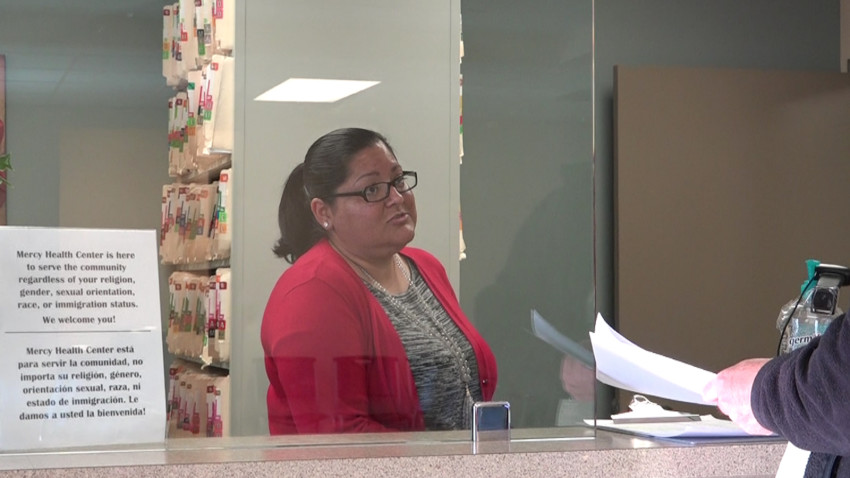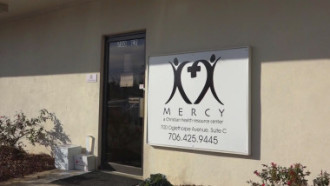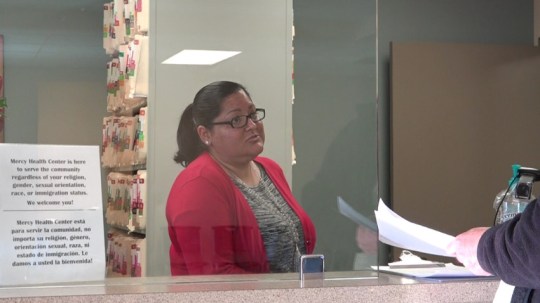As many travelers know from personal experience, it can be a challenge to get help for a sudden illness or injury if you and the local doctor don’t speak the same language.
But vacation ills are a relatively infrequent problem compared with the misunderstandings and complications that come up repeatedly for people who settle permanently in the United States. That’s certainly true for many recent Spanish-speaking immigrants.
Karina Drake, who was born in Chihuahua, Mexico, moved to Texas with her parents when she was a teenager. She lives in the Athens area now, and for the past five years has worked at Mercy Health Center, a safety net clinic that serves uninsured and underserved people in northeast Georgia.
She knows how culture shock plays out in the examination room.
Modesty is highly valued among traditional Mexicans, for example, and “some of these Hispanic patients do not feel comfortable taking some of their clothes off when they see a gynecologist or another doctor,” said Drake, who works at the front desk and serves as a Spanish interpreter at the Christian-centered clinic.
Drake’s mother, who spoke no English when the family first came to the United States, had painful experiences when she sought routine health care. As a result, Drake is keenly aware of “the frustration for a patient who doesn’t understand the language and is not able to communicate about what their needs are.”
Today, Drake is on the front lines of the push to make culturally appropriate health care more accessible. “When a Spanish-speaking patient walks through the door, she is able to welcome them and make them feel at home,” said Lauren Delmerico, the assistant director of Mercy Health Center. She praised Drake’s ability to guide patients through the paperwork and procedures involved in a modern visit to a doctor.
In 2011, Drake completed training and passed the examination to become a licensed nursing assistant. She has never been formally trained as a medical translator, but that is an important part of her duties.
Language and culture
Translation is no simple skill. Just as the mere fact of speaking a language doesn’t make a person a good communicator, the ability to speak two languages doesn’t necessarily make a person a good interpreter.
Drake takes the responsibility of translation seriously. She has used her native fluency in Spanish and her common sense, guided by experience, to arrive at a method that works.
Her approach is practical. “You can translate literally,” she says, or “you can translate the main thing that the person is trying to say.” She focuses on the essentials.
“It can actually be really dangerous if you are not relaying the information to the patients about their medication,” said Tyler Raeford, who is the pharmacy coordinator at Mercy.
The pitfalls of poor translation are numerous. For instance, dangerous misunderstandings can occur when one language has a name for something that the other does not. “So it’s definitely in our best interest to use fluent interpreters in our clinic,” Raeford said.
Interpreting for patients from another country is not just a matter of grammar and vocabulary. “If you are a translator who doesn’t understand their culture, you’ll translate things literally, and to the doctor it’ll not make any sense,” Drake said.
Drake also helps explain differences between the U.S. and Mexican health care systems. In Mexico, basic health care is provided by a social security program for everyone; wealthier people can also buy additional coverage from private insurance companies.
Nowadays, about one in 10 Georgians are Hispanic, and though they are a diverse population, the poverty rate among them is relatively high. Nearly half of them lack insurance, and many know little about how insurance even works. “They come here and they don’t understand the situation with the health insurance,” Drake said.
All told, Mercy serves about 3,000 uninsured Northeast Georgia residents each year, and “20 percent of our patient population is Spanish-speaking,” said Delmerico. For Hispanic people seeking free health care services, Mercy is one of the most accessible places they can think of.
Some Mercy patients are in this country illegally, and must show some form of identification to get care there, Drake said.
Hispanics have long been considered a high-risk medical population in the United States, in part because type 2 diabetes is more common for them than for other ethnic groups. That risk can be lowered through diet and exercise, but health advice isn’t always communicated effectively.
A 2012 study in California found that residents who were not fluent in English generally had less education than other people about how to live a healthy life.
“Diabetes, hypertension and overweight – those are the three main things that I notice in most of the Hispanic patients,” Drake said.
She seizes every opportunity to tell them, in Spanish, “Look, it’s important for you to exercise, it’s important for you to eat healthy.” She explains why talking to Mercy’s nutritionist about meal planning can help.
Diabetes patients often say they were told years earlier in Mexico about their high blood sugar levels, but didn’t get preventive advice back then. By the time they come to Mercy, most need drugs as well as behavioral changes to control their disease.
The issue of literacy
Mercy strives to make health education materials available in both languages. “We try to get most of our documents translated into Spanish,” said Delmerico, the assistant director. Educational videos playing on the monitor in Mercy’s waiting room are captioned in Spanish and English.
But not everyone can read those materials.
[youtube]https://www.youtube.com/watch?v=P9JPPkspePc[/youtube]Many of Mercy’s Hispanic patients “are a little bit older, and they come from villages and little towns in Mexico, they have no way to go to school and they don’t know how to write or read” in Spanish, let alone in English, said Drake.
Asked to sign a needed form, “they look at me and they start crying, and I look at them and I understand at that point that they don’t know how to write their names,” said Drake. “I try to be friends with them without hurting, and understand what they’re going through.”
In private life, Drake runs a small Bible study group, and she always asks the participants to pray for her patients. She shares their beliefs and speaks their language.
About 70 percent of Latinos identify themselves as Christian and the majority are Roman Catholic. The Christ-centered environment at Mercy helps create a strong bond between patients and Mercy staff.
“We believe it is so important to serve every patient that walks through our doors,” said Delmerico, the assistant director.
Drake is always looking for new ways to be of service to all Mercy’s patients, including non-Hispanic immigrants.
“I love to talk to people from other countries and ask them, ‘Hey, how do you say this in your language? Would you please write it down for me?’ ” said Drake. “So I am very open to other cultures as well.”
Ruobing Han is a master’s student in health communication at the University of Georgia. She is especially interested in vaccine promotion.



